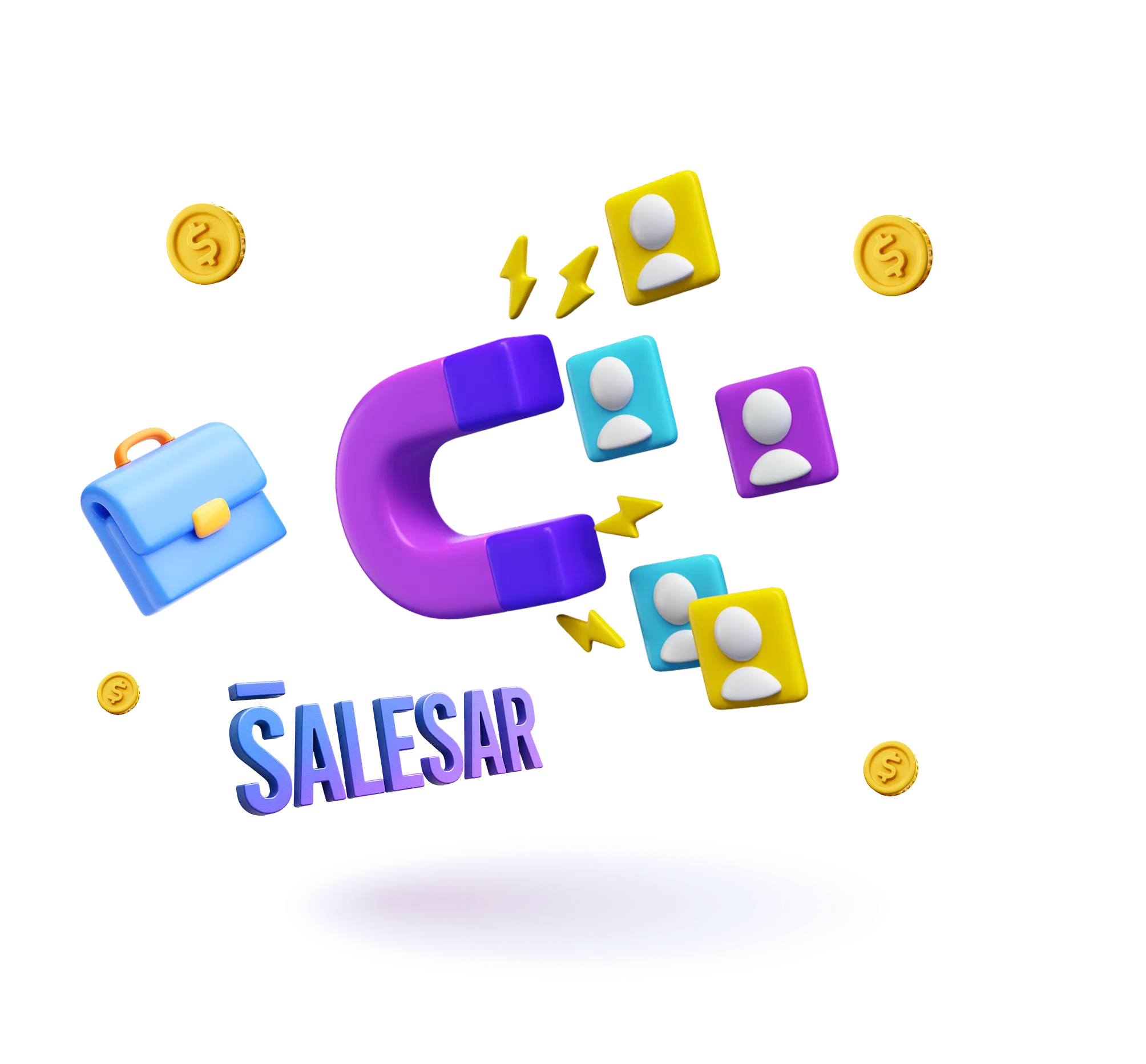Think about the last time you made a serious business decision. Did you just click on one ad and sign the deal? Probably not. You checked LinkedIn, maybe saw an email, did a quick Google search, and a few weeks later, clicked on a retargeting ad.
McKinsey reports that 73% of B2B buyers utilize multiple channels throughout their purchasing journey. That means your next customer could touch three, five, or even seven different channels before booking a meeting. From what we’ve seen at SalesAR, relying on a single channel rarely gives you a stable or scalable pipeline.
Benefits of Cross-Channel Marketing
Imagine this: your sales team runs email outreach, your marketing team pushes LinkedIn ads, and someone else is running Google retargeting. Sounds like a lot of effort, right? But if those efforts aren’t aligned, what does the buyer experience?
- A scattered set of disconnected messages.
- An email claiming one thing, an ad stating another, and a LinkedIn post conveying a completely different message.
- Noise instead of strategy.
Now flip the script. Picture a prospect’s journey when everything is synced:
- They see a LinkedIn post with a clear value proposition.
- The next day, they get a well-researched email with the same message tailored to their role.
- They visit your site, leave, and then see a retargeting ad that reminds them of the exact pain point mentioned in the email.
- It feels like one continuous, personalized conversation.
SalesAR Insight: The numbers make the case even stronger: brands using three or more channels in campaigns see a 287% higher purchase rate compared to single-channel efforts.
Here’s what we’ve seen at SalesAR when campaigns align across email, LinkedIn, and retargeting:
- Increased trust from consistent messaging.
- Higher SQL conversion rates, not just more leads.
- Prospects moving smoothly through the funnel instead of feeling “marketed to.”
Cross-channel marketing isn’t about being everywhere for the sake of it. It’s about being consistent everywhere, and when done right, a cross-channel strategy turns scattered touches into a unified buyer journey that drives real pipeline growth.
See how SalesAR’s omnichannel approach can deliver results.
Challenges in Cross-Channel Lead Generation
Let’s be honest: running campaigns across multiple channels can get messy fast. I’ve seen companies combine email, LinkedIn, and paid ads without a clear plan, and the result is chaos. Marketing pushes one set of messages, sales is chasing leads with another, and data? It’s scattered across five different tools that don’t talk to each other. Buyers feel the disconnect immediately.
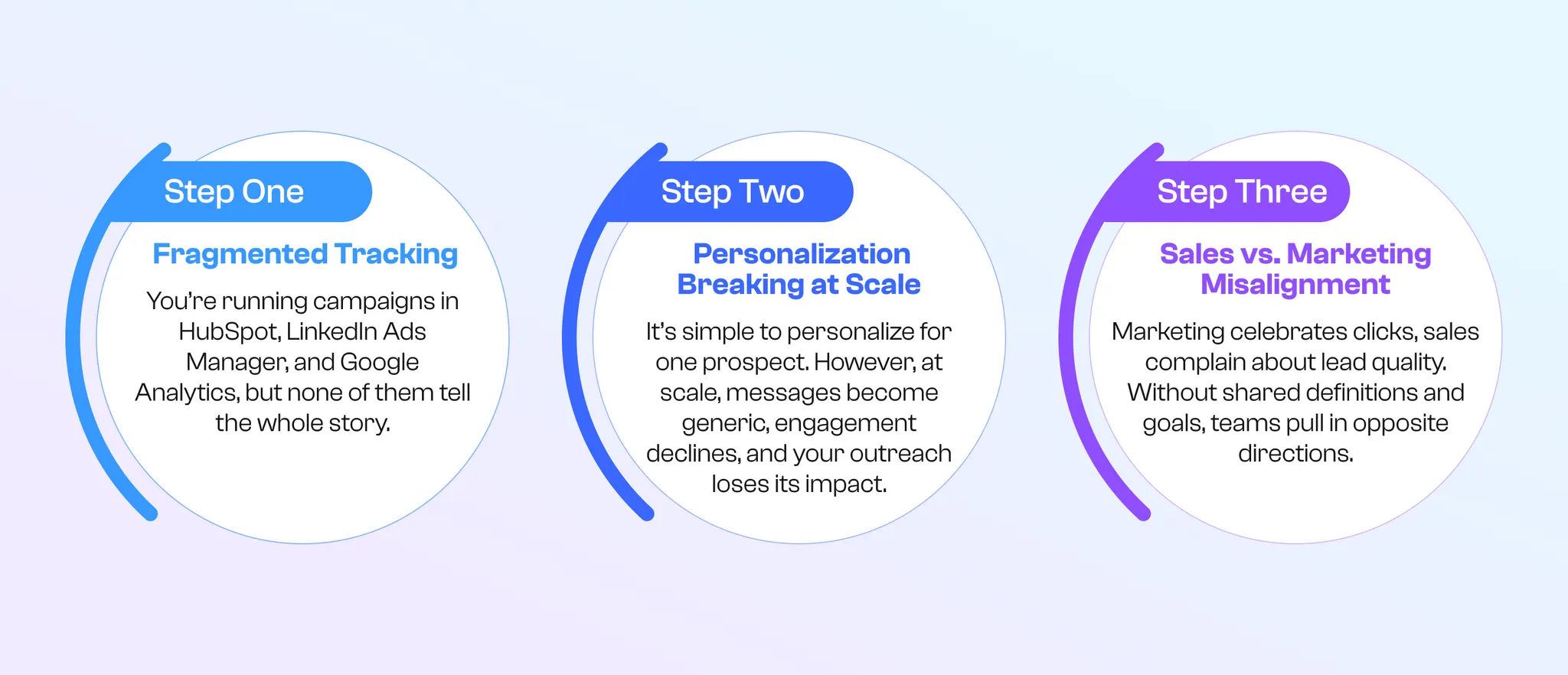
Here’s what usually goes wrong:
- Fragmented tracking — You’re running campaigns in HubSpot, LinkedIn Ads Manager, and Google Analytics, but none of them tell the full story. Which touchpoint brought in the SQL? Who knows. Attribution becomes guesswork.
- Personalization breaking at scale — It’s easy to write a tailored email for one prospect. It’s much harder to deliver that same relevance when you’re reaching thousands. Messages start feeling generic, and engagement drops.
- Sales vs. marketing misalignment — Marketing celebrates high click-through rates, while sales is frustrated with the quality of leads. Without a shared definition of success, both teams pull in different directions.
The fix begins with clarity: a single shared funnel view, a unified messaging framework, and a consistent definition of what constitutes a qualified lead. Without that, more channels just mean more noise. With it, every channel becomes another layer of trust-building, guiding the buyer closer to a real conversation.
So the question isn’t, “How many channels should we use?”
The better question is, “How do we make sure every channel works together as one?”
That’s where cross-channel stops being chaos and starts building pipelines that actually convert.
Tools for Cross-Channel Campaigns
Picture the start of a campaign manager’s day. First stop: the CRM. They’re checking which leads came in overnight, reviewing which deals are moving forward, and scanning activity logs to see how yesterday’s emails and LinkedIn touches performed.
Next, they dive into the email platform to monitor reply rates on sequences, adjust subject lines, or pause underperforming steps. Then it’s over to LinkedIn — engaging with comments, sending follow-ups, and tracking connection requests. By afternoon, they’re in the ad manager, fine-tuning retargeting for mid-funnel prospects who’ve visited the site but haven’t booked a meeting. And throughout all of this, they need clean reporting across every channel. That’s where cross-channel integration comes in, connecting these moving parts into one system instead of scattered efforts.
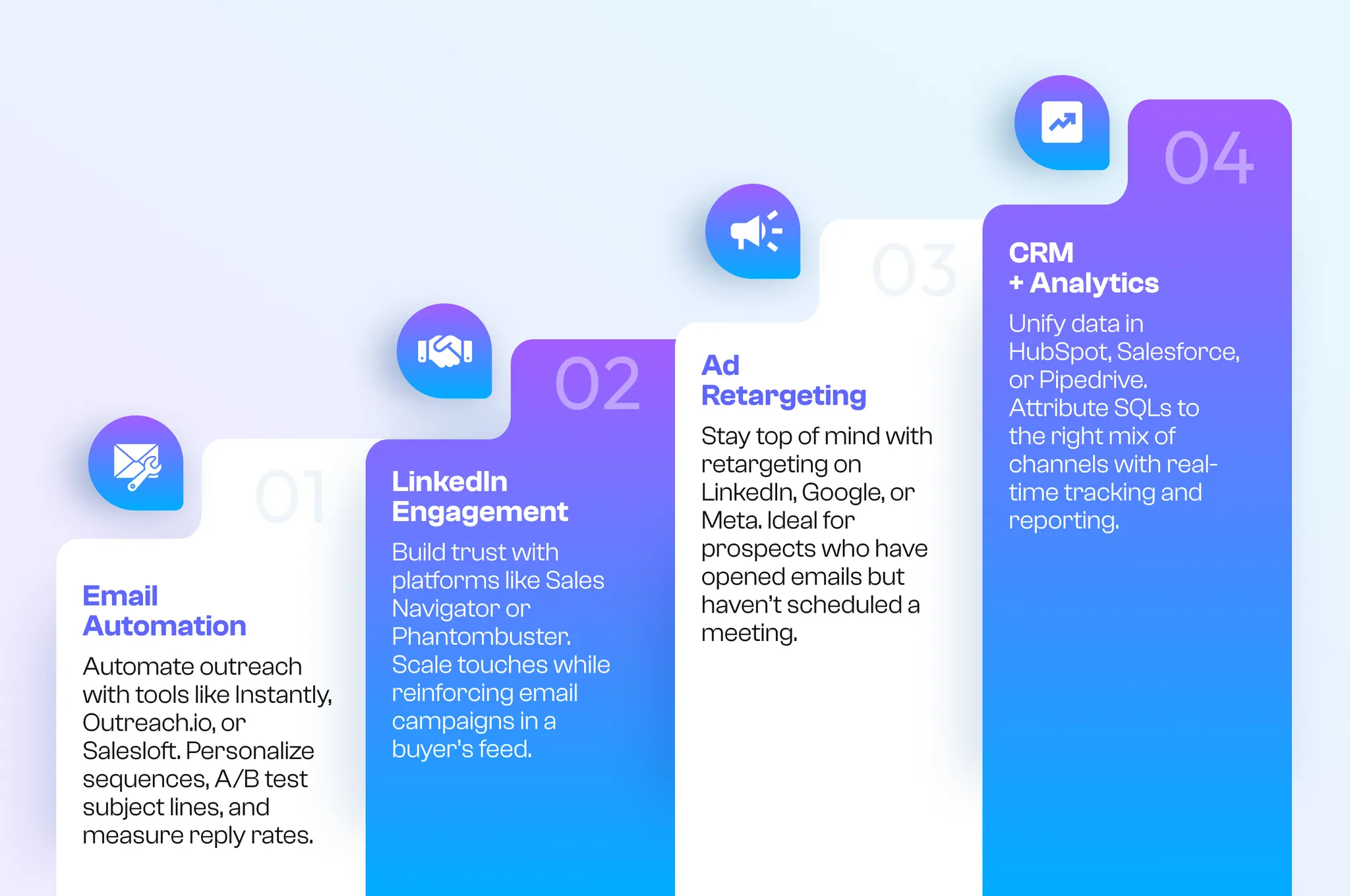
Email Automation & Lead Generation Sequences
Email remains the backbone of outbound marketing. Lead generation tools like Instantly, Outreach.io, or Salesloft help automate sequences while maintaining personalization and effectiveness. The key is to combine structured outreach with tailored touches, so prospects don’t feel like they’re reading a mass blast. A/B testing subject lines and measuring open/reply rates are standard practices.
LinkedIn Engagement Platforms
LinkedIn is where professional trust is built. Platforms like LinkedIn Sales Navigator or Phantombuster help scale touches: connection requests, follow-up messages, and content engagement. The goal is to reinforce email efforts, not replace them. Think of it as showing up twice in a buyer’s inbox: once in their email, once in their feed.
Ad Retargeting for Mid-Funnel Prospects
Retargeting on LinkedIn, Google, or Meta keeps you top of mind. A prospect who’s opened your email but hasn’t replied will see an ad reinforcing your message. This works especially well for mid-funnel prospects.
CRM + Analytics for Unified Tracking
A central CRM, such as HubSpot, Salesforce, or Pipedrive, ties it all together. This is where you unify the view of the funnel: seeing which sequences led to meetings, which ads generated engagement, and how LinkedIn touches contributed. With proper analytics, you can attribute SQLs to the right mix of channels instead of guessing.
SalesAR Insight: The best practice is simple: don’t let these tools live in silos. Always connect them so insights flow both ways. If someone clicks an ad, sales should see it. If a lead replies on LinkedIn, marketing should know before sending another email. That’s how you turn tools into a system that consistently builds a pipeline.
How to Build Lead Generation Sequences Across Channels
One of the biggest mistakes I see is when outreach is treated like a series of disconnected “shots.” An email blast here, a LinkedIn message there, maybe a call if time allows. The problem? Prospects don’t experience it as one campaign. The smarter approach is to think of outreach as a continuous conversation that moves smoothly across channels, guiding the buyer from initial contact to a sales-qualified lead.
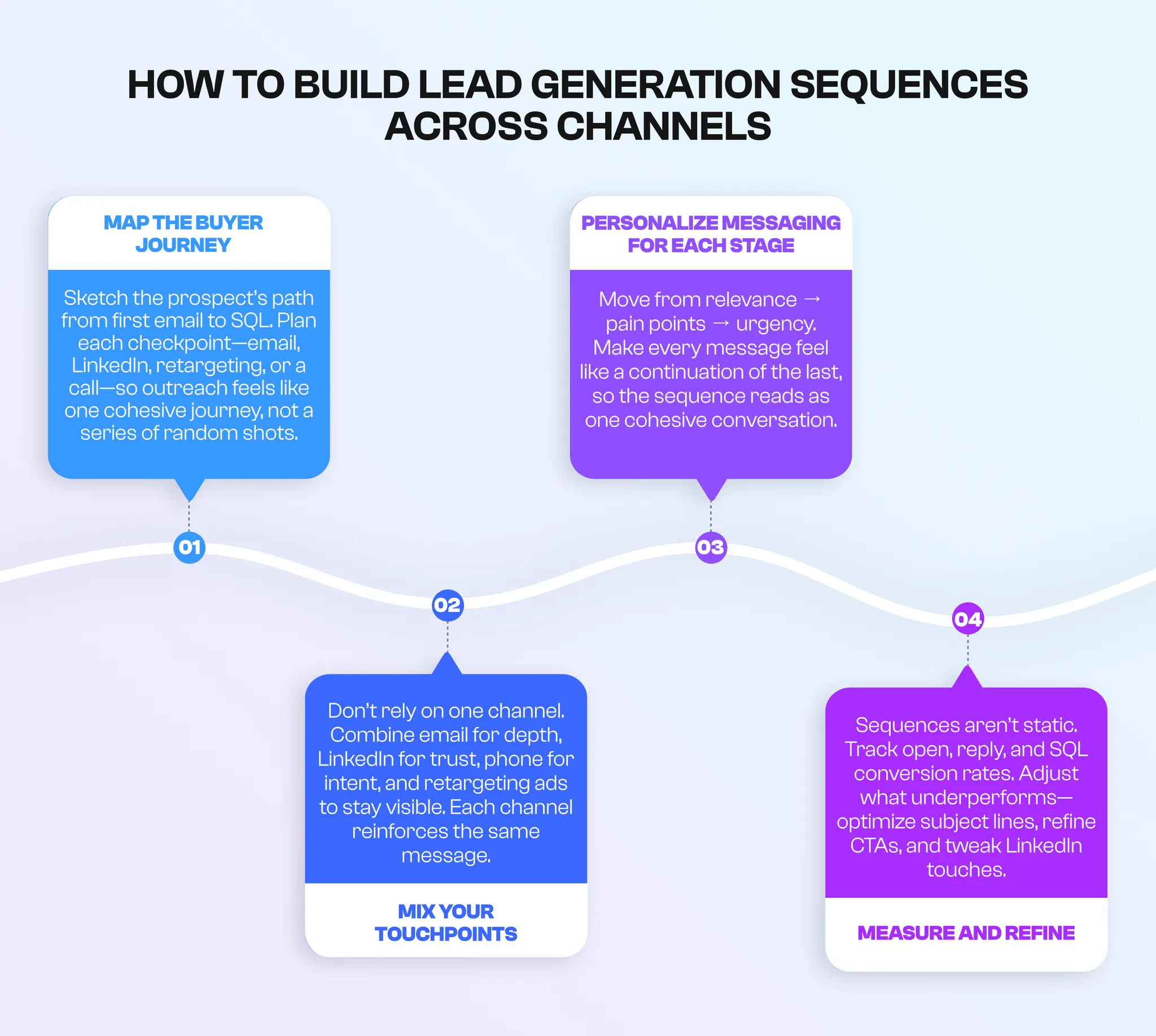
Step 1: Map the Buyer Journey
Start by sketching the path you want prospects to take. What happens after they open your first email? Do they get a LinkedIn touch two days later? If they don’t respond, should they see a retargeting ad or get a call from your SDR team? Having this mapped out ensures you’re building a journey, not random outreach attempts.
Think of each step as a checkpoint that either nudges the prospect forward or re-engages them if they drop off. Without this structure, even the best content falls flat because it’s out of sync.
Step 2: Mix Your Touchpoints
The best sequences don’t rely on one channel. Instead, they layer them:
- Email for detailed value propositions and tailored outreach.
- LinkedIn outreach for credibility and casual engagement.
- Phone calls for higher-intent prospects who’ve already engaged.
- Retargeting ads for staying top-of-mind between direct touches.
When you combine these, you’re reinforcing your message wherever they’re active.
Step 3: Personalize Messaging for Each Stage
Personalization isn’t just about using a first name. It’s about context. In the early stage, focus on relevance: “Here’s why we’re reaching out.” Mid-sequence, address specific pain points: “We’ve helped companies in your industry solve this.” By the later stages, shift toward urgency: “We’d love to explore this before Q4 planning is locked in.”
Each message should be a logical continuation of the last. If someone read every email, LinkedIn touch, and ad in sequence, it should feel like one cohesive conversation.
Step 4: Measure and Refine
The best sequences are never static. Track open rates, reply rates, and conversion to SQLs. If LinkedIn touches aren’t getting engagement, adjust the messaging. If emails are being opened but not replied to, refine the call-to-action.
SalesAR Insight: We’ve seen the impact of this structured approach firsthand. In one campaign, simply aligning the sequence across email, LinkedIn, and retargeting reduced the time to reply to a meeting by 30%. Prospects were moving through the funnel faster because every channel reinforced the same narrative.
Multichannel Marketing vs. Cross-Channel Lead Generation
Here’s a scene I’ve watched play out too many times: a company launches email campaigns, runs LinkedIn ads, and invests in paid search. On paper, it appears to be a multichannel success. But when you look closer, the cracks show.
The email talks about efficiency, the LinkedIn ad focuses on cost savings, and the search ad promises innovation. To the buyer, it feels like three different companies competing for attention.
That’s the trap of multichannel marketing. Yes, you’re present on multiple platforms, but the experience isn’t consistent. And consistency matters more than most people realize: 64% of B2B decision-makers say inconsistent messaging reduces trust.
Cross-channel lead generation fixes that problem by unifying the experience. Instead of fragmented campaigns, every touchpoint builds on the last. A LinkedIn post introduces the idea, an email reinforces it with specifics, a retargeting ad reminds prospects a week later, and a call ties it all together. Same message, same story — just adapted for the channel.
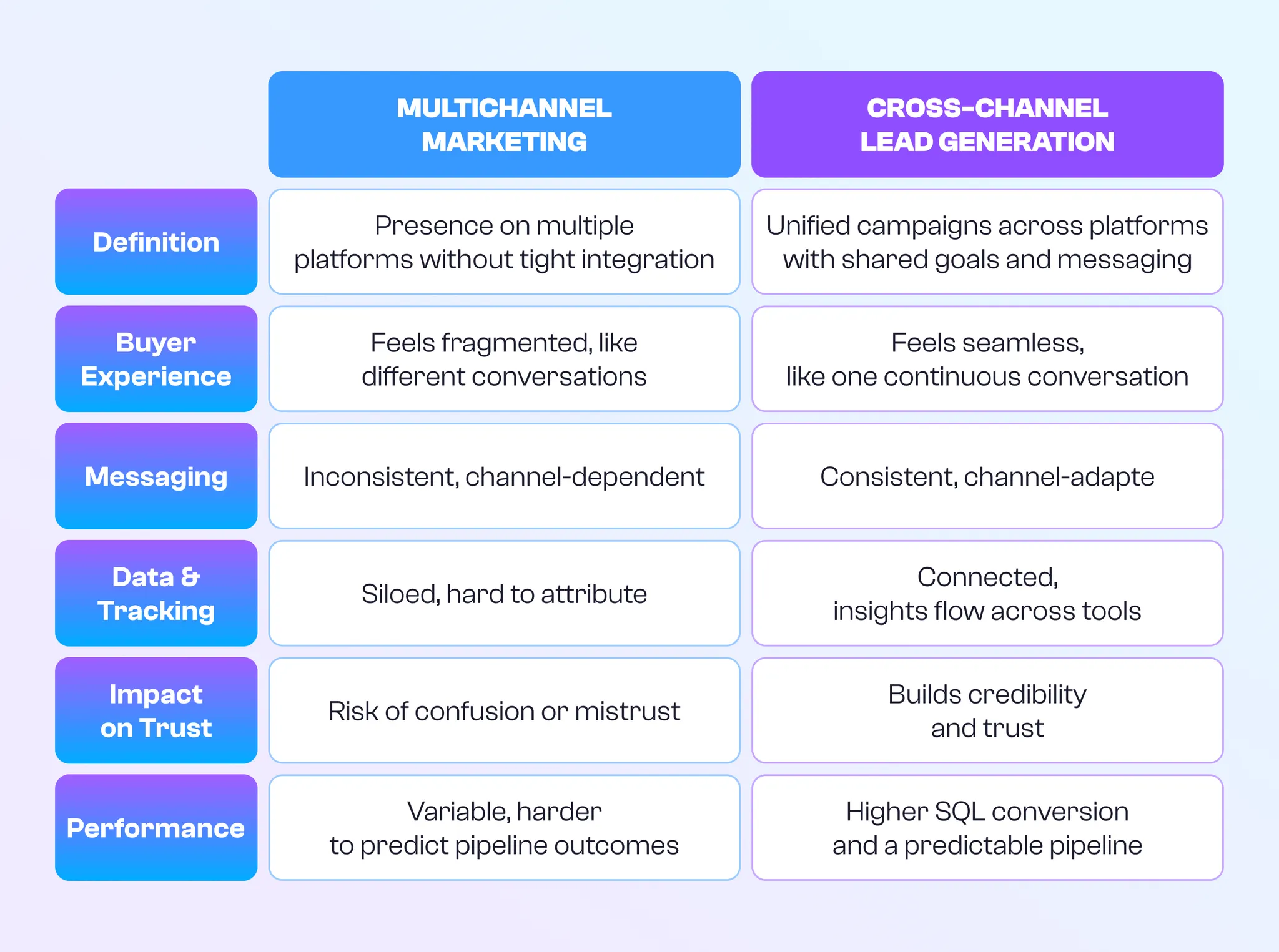
At SalesAR, we’ve seen why cross-channel consistently outperforms multichannel. It’s about whether those platforms reinforce each other. When every channel works as part of one strategy, prospects stop feeling sold to and start feeling understood. That’s when conversations turn into real opportunities.
If you’d like a deeper dive into how these approaches evolve, check out our complete guide on omnichannel lead generation in 2025.
The Future of Cross-Channel in 2025 and Beyond
Buyers don’t just want to be “reached”, they expect interactions that feel personal, timely, and relevant. The companies that still rely on batch-and-blast campaigns will find themselves overlooked, while those that build truly connected, human-like experiences across channels will emerge victorious.
So what’s shaping the next wave of cross-channel lead generation?
AI-Powered Personalization
Personalization used to mean tweaking a first name or job title. In 2025, that’s baseline. With AI tools, teams can analyze intent data, recent activities, and company updates in real-time, then tailor their outreach accordingly. Imagine an email that references a prospect’s latest funding round, followed by a LinkedIn touch congratulating them, and then an ad highlighting solutions relevant to companies at their stage. According to Salesforce, 66% of B2B buyers expect vendors to understand their unique needs.
Real-Time Data Unification
The biggest frustration for sales and marketing teams today is the fragmentation of data. In the near future, CRMs, ad platforms, and outreach tools will synchronize in real-time. No more wondering whether a prospect opened an email before they saw a LinkedIn ad. No more missing signals because one platform lagged. With proper cross-channel integration, SDRs and AEs can act on the most current insights and strike while the timing is right.
Video-First and Interactive Engagement
Static emails are losing their edge. Buyers want to see, hear, and interact with products. Expect more video-first outreach, whether it’s a 30-second personalized intro or a recorded product walkthrough. Interactive demos that prospects can click through at their own pace will also play a bigger role, giving buyers a sense of control before they even speak with a sales representative.
Community-Led Growth
Slack groups, LinkedIn communities, and even niche Discord servers are becoming B2B watering holes. Buyers want to learn from peers, not just vendors. Companies that appear in these spaces will earn credibility and a pipeline indirectly. Community isn’t just brand awareness; it’s lead generation in disguise, because prospects trust peers more than paid ads.
Conclusion
Lead generation in 2025 isn’t about adding more noise to an already crowded market. Buyers are tired of being bombarded with random messages. What they respond to is a conversation that feels seamless. At SalesAR, we’ve helped companies transform fragmented outreach into a cross-channel strategy that consistently converts.
Start building a pipeline that works across every channel, every time.
FAQ
What are the channels for cross-channel lead generation?
Cross-channel campaigns usually combine email outreach, LinkedIn engagement, phone calls, ad retargeting, and community interactions like LinkedIn groups or Slack forums. The real impact comes when these touchpoints work together, creating a unified experience rather than separate attempts.
How does cross-channel differ from omnichannel lead generation?
Multichannel means simply being present on several platforms, while omnichannel is more common in B2C and focuses on blending online and offline experiences. Cross-channel lead generation is B2B-focused. It aligns sales and marketing so every channel supports the same funnel, uses consistent messaging, and shares insights across systems.
What are common mistakes in cross-channel lead generation?
One of the most frequent mistakes is running campaigns in silos where tools and teams don’t share data. Another is sending inconsistent or conflicting messages across platforms, which confuses prospects. Companies also struggle when they overload buyers with too many touchpoints, rely on surface-level personalization, or allow sales and marketing to pursue different objectives.
Why is cross-channel lead generation important in 2025?
B2B buyers rarely make decisions after a single touch. They move between email, LinkedIn, ads, and peer communities before ever booking a call. 73% of buyers use multiple channels during their journey, and 64% of decision-makers lose trust when messaging doesn’t align. In 2025, cross-channel matters because it delivers consistency, builds credibility, and creates a smoother path from first contact to SQL.

